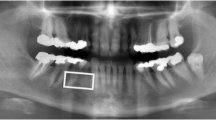Abstract
Visual assessment of femoral osteopenia (the radiographic presentation of osteoporosis) is unreliable. Many of the short-comings of observer grading can be overcome by digital image analysis. Our group has developed algorithms to make automatic assessment of osteopenia from clinical radiographs. Texture Analysis Models (TA) commonly used in image analysis were investigated as measures of osteopenia. Unlike densitometric methods, TA characterizes properties of thestructure of the image (ie, trabecular patterns). A group of women were analyzed whose subjects ranged from those at risk of osteoporosis (n=24) to normal (n=40). Using an IBM PC, frame-grabber, camera, and light-box, we appraised five statistical TA algorithms for assessment of the femoral neck in standard pelvic radiographs: (1)Fractal Signature (FS) describes the image’s fractal nature. (2)Auto-Correlation of unaltered and Sobel Edge Transformed images (ACSE) measures image spatial self-similarity. (3)Co-occurrence Matrices (CM) gives the joint probability of greylevels with distance/direction and describes statistical relationships of image variation. (4)Textural Spectrum (TS) neighborhood pixel relationships measure regional directional and pixel-inversion properties. (5)Eular Numbers (EN) describe texture by properties (such as connectivity) of binary images. Good reproducibility from repeated analysis of radiographs was shown using both pairedt-tests and Altman-Bland’s methods. We have shown a correlation between femoral neck bone mineral density (BMD—the “gold standard” of osteoporosis assessment) and textural measures for all five algorithms. Significant measures of osteopenia were: ACSE (r=0.6,P < .001), CM (r=−0.69,P < .001), FS (r=0.35,P < .01), TS (r=0.52,P < .001) and EN (r=−0.39,P < .01). Relationships were also found between textural characteristics and age/weight. TA techniques characterize the radiographic changes of bone in osteoporosis. Technology based on these ideas may have a place alongside BMD measurements in the assessment of this condition.
Similar content being viewed by others
References
Wallach S, Feinblatt JD, Avioli LV: The Bone “Quality” Problem. Calcif Tissue Int 51:169–172, 1992
Singh M, Nagrath AR, Maini PS: Changes in the trabecular pattern of the upper end of the femur as an index of osteoporosis. J Bone Joint Surg 52-A:457–467, 1970
Zucker SW, Terzopoulos D: Finding structure in cooccurrence matrices for texture analysis. Computer Graphics and Image Processing 12:286–308, 1980
Sonka M, Hlavac V, Boyle R: Texture, in Sonka M, Hlavac V, Boyle R (eds): Image Processing, Analysis and Machine Vision. London, UK. Chapman and Hall, 1993, pp 480–485
Dong-Chen H, Li W: Texture features based on texture spectrum. Pattern Recognition 24:391–399, 1991
Gonzalez RC, Woods RE: Image segmentation, in Gonzalez RC, Woods RE (eds): Digital Image Processing. New York, NY, Addison Wesley, 1992, pp 416–429
Gonzalez RC, Woods RE: Image Enhancement, in Gonzalez RC, Woods RE (eds): Digital Image Processing, New York, NY, Addison Wesley, 1992, pp 209–213.
Rosenfeld A, Kak AC: Enhancement, in Rosenfeld A, Kak AC (eds): Digital Picture Processing. New York, NY, Academic, 1976, pp 173–175
Lynch JA, Hawkes DJ, Buckland-Wright JC: A robust and accurate method for calculating the fractal signature of texture in macroradiographs of osteoarthritic knees. Med Inform 16:241–251, 1991
Geraets WGM, Van Der Stelt PF, Netelenbos CJ, et al: A new method for automatic recognition of the radiographic trabecular pattern. J Bone Miner Res 5:227–233, 1990
Gonzalez RC, Woods RE: Representation and Description, in Gonzalez RC, Woods RE (eds): Digital Image Processing. New York, NY, Addison Wesley, 1992, pp 548–560
Altman DG, Bland JM: Measurements in medicine: The analysis of method comparison studies. The Statistician 32:307–317, 1983
Bland M: Clinical measurement, in Bland M (ed.): An Introduction to Medical Statistics (ed 2). Oxford, UK. Oxford Medical Publications, 1995. pp 266–269
Author information
Authors and Affiliations
Additional information
Supported by SmithKline Beecham Pharmaceuticals, New Frontiers Science Park, Harlow, Essex, UK, PhD Studentship.
Rights and permissions
About this article
Cite this article
Lee, R.L., Dacre, J.E. & James, M.F. Image processing assessment of femoral osteopenia. J Digit Imaging 10 (Suppl 1), 218–221 (1997). https://doi.org/10.1007/BF03168705
Issue Date:
DOI: https://doi.org/10.1007/BF03168705




